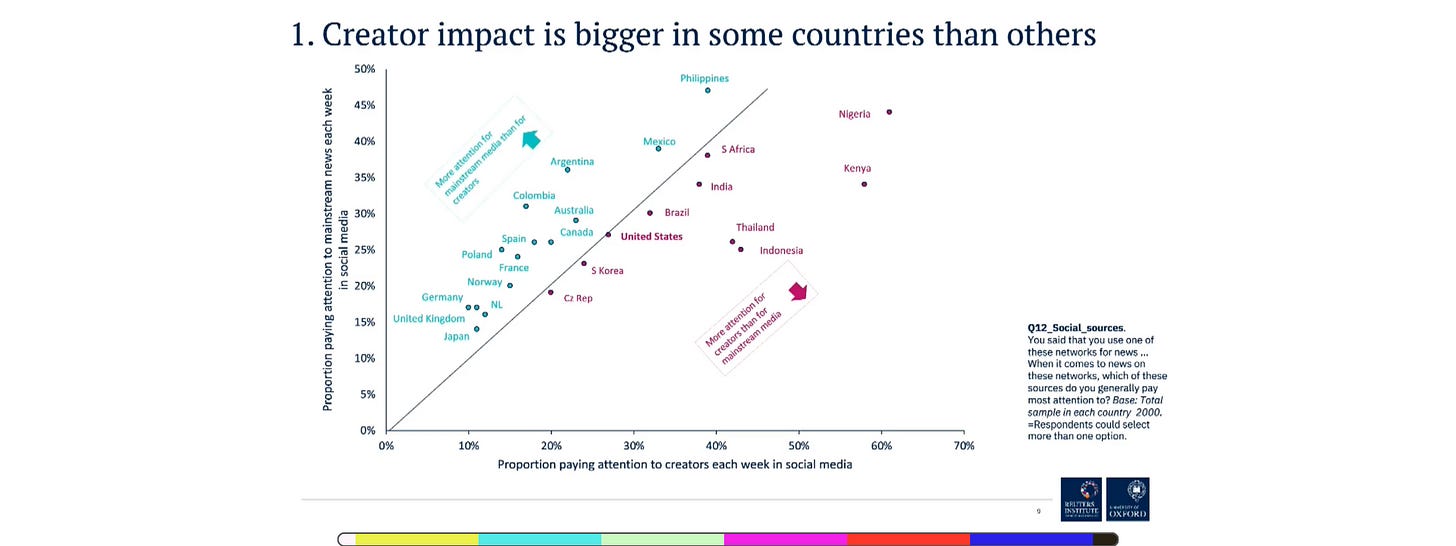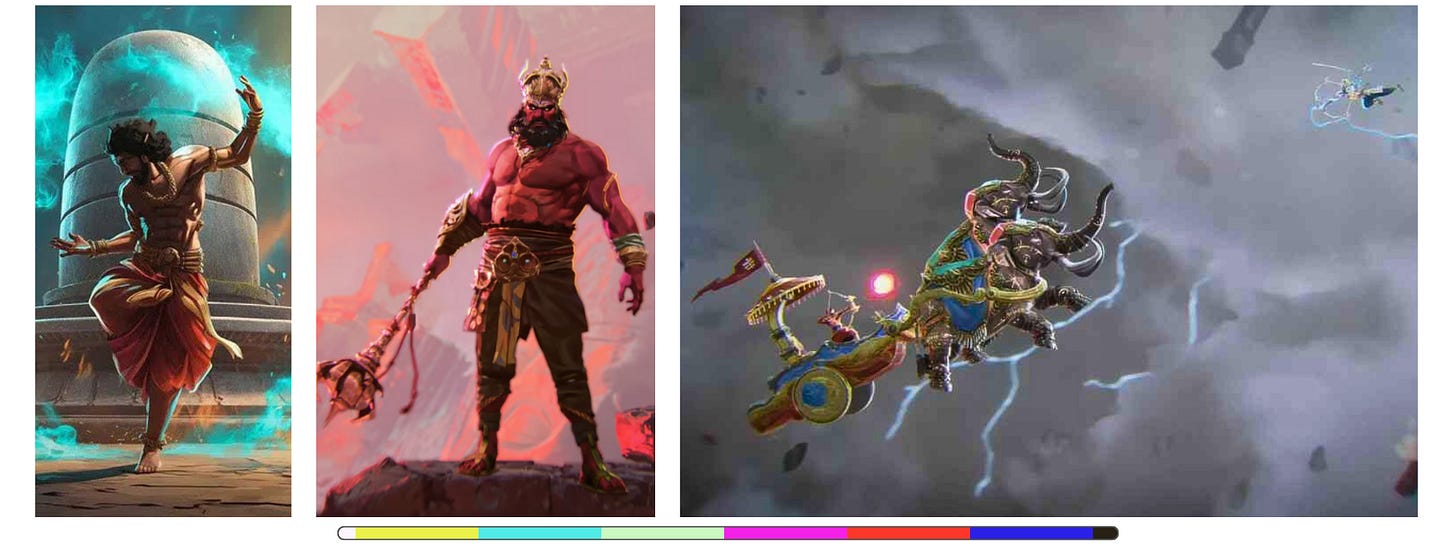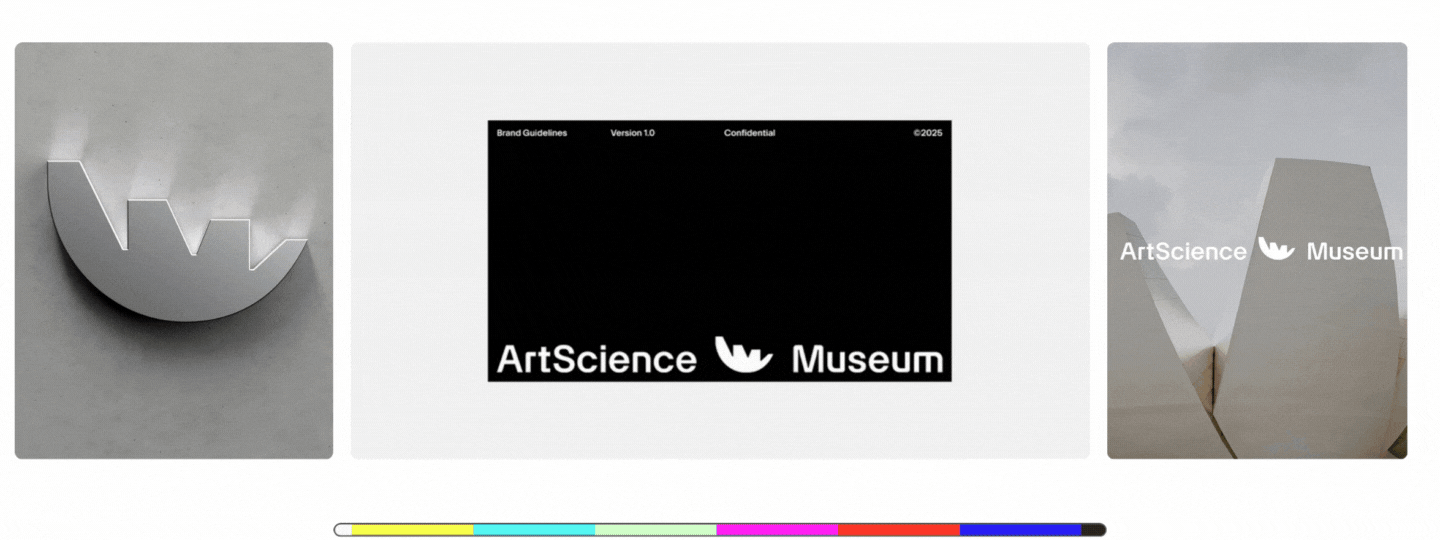The News Mess
· news & creators · London postcards · convergence ·
I was immersed this week in looking at the shifting sands in ‘news media’, inspired by a fascinating global report from the Reuters Institute which looked at creators in the space.
But as always on The Colour Bar, there is visual delight from brands, an animated tease, and a bunch of stories to poke your nose into.
The News Mess: a dive into news in the time of creators.
▶️ Curated/Cuts: Burberry’s romance with London, Singapore’s Art Science Museum, an Indian blockbuster goes animated.
➕ the Youtube vs Reels revenue race; Sky Sports abortive Tiktok channel; Amazon’s confidence resurrection of an old ad; Sameer Nair on Indian media, sports streaming in Japan.
☝🏽Busy? Lazy? Multitasky? Click play above and let me read this to you.
The News Mess
Not new, still messy.
When I look at my personal news landscape and that of my community (real and digital), I most often pause on two elements: trust, and engagement.
I find trust at a strange place- connections with individuals and creator brands is predicated on trust and connection, but also on the comfort of similar worldviews. The two don’t always chart the same path.
Engagement in news suffers from the same issues as elsewhere, though arguably with more at stake. Algorithms, virality, monetisation- these ideas are shaping a pillar of our society which they really shouldn’t be- journalism.
Creators up, trust down, attention tight.
The Reuters Institute has published ‘Mapping news creators and influencers’, a report tracing how news consumption around the globe is shifting towards personalities and creators. This is a sprawling, audience-centric study across social and video platforms in 24 countries. It showcases what many instinctively know- news sources have become messy, fragmented, and loosely defined.
At the core is the blunt, useful point, though made with care & nuance: the mechanics of attention have shifted. Audiences, especially younger ones, now meet news through people, not institutions or media brands. This is not framed as inherently good or bad. It’s just how our world looks, when distribution is mediated by social and video platforms, rather than newsrooms or front pages.
As all this is thrown into the algorithm(s), it makes for a bewildering cocktail, but one that is also richly creative, entertaining, and informative – even if much of that information cannot always be taken on trust.
In many ways we are still in the early trajectory of this shift. But it is hard to take lightly what is at stake, as journalistic approaches are challenged and societal narratives and mindsets are shaped. The interplay of platforms, AI, and regulation can be quite telling in the coming years.
I watch this space alternating between excited optimism and concerned weariness. :)
The new shape of news consumption.
Head over to check out the report, or lets jump into some key takeaways:
The shift is very uneven. Creators dominate in large markets like Brazil, Mexico, Indonesia, the Philippines, the United States, while in parts of northern Europe and Japan, traditional news brands still hold sway. Creators seem to be thriving where trust in institutions is shaky, and social use is high.
The ‘creator economy’ for news is no monolith. It’s a sprawl of audiences, each with their own trusted voices. Only a handful of creators reach very large audiences- think Joe Rogan, Tucker Carlson, Dhruv Rathee, Fabrizio Romano, HugoDécrypte. But most creators live in a longtail.
Most creator attention remains along national lines. But in many English-speaking countries, right-leaning political commentators from the USA, such as Rogan, Carlson, and Ben Shapiro, have found “fertile ground for their pro-free speech and anti-mainstream media narratives”. In parallel, football transfer specialist Fabrizio Romano is mentioned by respondents in almost every country!
Male domination- 85% of the top 15 in each country are men. The Philippines has the highest proportion of female news creators & journalists (54%). There was this little gem, “Political commentary is particularly prone to male-dominated presentation, with hosts often talking with other men into very large microphones.” (emphasis mine!)
YouTube lies at the heart of this landscape. IG and Tiktok are favoured by creators who explain or simplify the news. There are many exceptions, though- Instagram is widely used for political commentary in India, Indonesia, and Latin America; Facebook is still key in the Philippines and Thailand.
I also found the study’s typology/ classification instructive (even if inevitably fuzzy), because it resists lumping everything together. The authors separate creators with four broad approaches:
Commentary- often partisan, cheaply produced, “unconstrained by traditional impartiality norms”, the vast majority produced by men.
News/investigation- smaller in number, sometimes rigorous, including open-source investigations
Explainers- creators who simplify complex topics, often for younger viewers.
Specialism- niche experts and former journalists, building focused communities.
Commentary drives reach and heat; investigation carries journalistic standards but struggles for revenue; explainers often remix mainstream reporting and can help younger audiences catch up; specialists have commercial and subscription potential.
It is a messy ecosystem where politicians, legacy newsrooms, creators, lifestyle influencers and investigators now compete in the same feeds. That means creativity and utility, but it also means audiences are exposed to a lot of unverified or partial material.
our data suggest that algorithmically driven platforms are pushing both creators and audiences towards more sensational and partisan approaches.
The report highlights several creator-led ventures and newsroom experiments, including individuals who have scaled into media outfits, and legacy brands partnering with creators. The boundaries between creators and institutions are shifting.
There is also a less lofty reality the report stresses: being a creator is often grinding work. Burnout, uncertain monetisation, and the pressure to keep algorithmic attention make longevity hard.
Being a creator is a popular ambition for many young people, but few are making significant amounts of money. Starting things is often fun, but keeping them going can be a grind.
If I must drop a single takeaway? The future of news will be plural.
Creators add elasticity to how news is produced and consumed. Reach and relevance will often be enhanced, while complicating verification, accountability and the economics of serious (reliable) reporting. This messy courtship between creators and journalism is where we seem to be. The next few years of news innovation, adaptation and yes- regulation- are more key than many might realise.
Report authors: Nic Newman, Amy Ross Arguedas, Mitali Mukherjee and Richard Fletcher
🎬 Curated/Cuts.
1. Postcards from London
It’s Always Burberry Weather: Postcards from London was a new set of films last month from the British brand. Burberry’s love affair with Olivia Colman continues (no complaints from me!); each spot features her, with different first-time tourists to the great city (and the Trenchcoat).
These visitors variously dabble in what London has to offer- hesitantly, confidently obliviously, happily. Fish & chips, buskers, museums, cricket… and the promise of a sandwich.
How chivalrous…
Cod or Haddock?
You’re dripping cricket…
The only red flag? A terrible umpiring decision! Sounded like bat, way down the pitch, what a poor LBW call, umpire! Bah.
They also went ahead and did some quick & dirty, amusing dummy Weather Reports from the same cast. All of these in a Youtube playlist here.
· Directed by Daniel Lee ·
2. Eternal Wars
If you haven’t heard of Baahubali, go look it up. A fantastical action smash shit from India a few years ago (in two parts). Now, we have the first look for a promised animated extension of that universe. With a coming together of some killer animation teams- India’s Arka Productions partnering with Aniventure, Zaratan and Alcyde- it promises all the chops.
There has been much “this gonna be like Arcane!” energy that has ensued.
Check out the teaser here.
Helming it is Ishan Shukla, indie animation filmmaker who directed an episode of ‘Star Wars: Visions’. Bahubali: The Eternal War here and a chat with the director here. Bahubali Eternal - animated
3. Convergence
Singapore’s (fairly iconic) ArtScience Museum has just had a rebrand around the concept of convergence, done by Project 3. Their “graphic language of convergence can be distilled into three pillars: intersections, overlays, and dynamic” forms.”
Playlist
Sameer Nair was on The Media Room recently. Its always good to listen to the man who has been at the centre of much that has happened in Indian media. He is invariably insightful, incisive and grounded in the realities borne of three decades in the entertainment business. He reflects on the transformation in entertainment in India, touching on the primacy of quality (not cost) and why “there is no bottom of the pyramid in entertainment.”
It’s a good stroll through the evolution of narrative formats, the streaming business, stardom, with an inevitable touch on AI in creative work.
“There is an opportunity to now entertain a billion Indians who have been fed on a very robust and energetic TV industry for the last 30 years.”
➕
Reels vs Youtube? “The two platforms suddenly appear to be neck-and-neck for budgets. But it’s not that simple.”
“Marketers get sick of their ads much quicker than consumers do.” Amazon brought back a well-received brand-building ad from 2023, for 2025.
Sky Sports killed their new TikTok channel ‘Halo’ after three days, amidst claims it was sexist and patronising. “So condescending. Creating a dumbed down sports channel for women is unbelievably sexist. Incredible that it was approved”
“sports streaming is a dream realized: Fans can watch their teams anytime, anywhere…. The dream comes with fine print — an endless chase for the right platform, the right package and enough room in the household budget to keep the games on”. Japan fully enters sports streaming era as fans face new dilemmas
If you enjoy The Colour Bar, maybe help fuel the next one!
In my other Substack newsletter, Coffee & Conversations, I considered things coming to an end. We experience endings in small, significant, silly, sentimental, simple, and different ways. Sometimes, it’s a pact, with an end date. Other endings you wish for.
Some are less forgiving. Go on, have a read.











